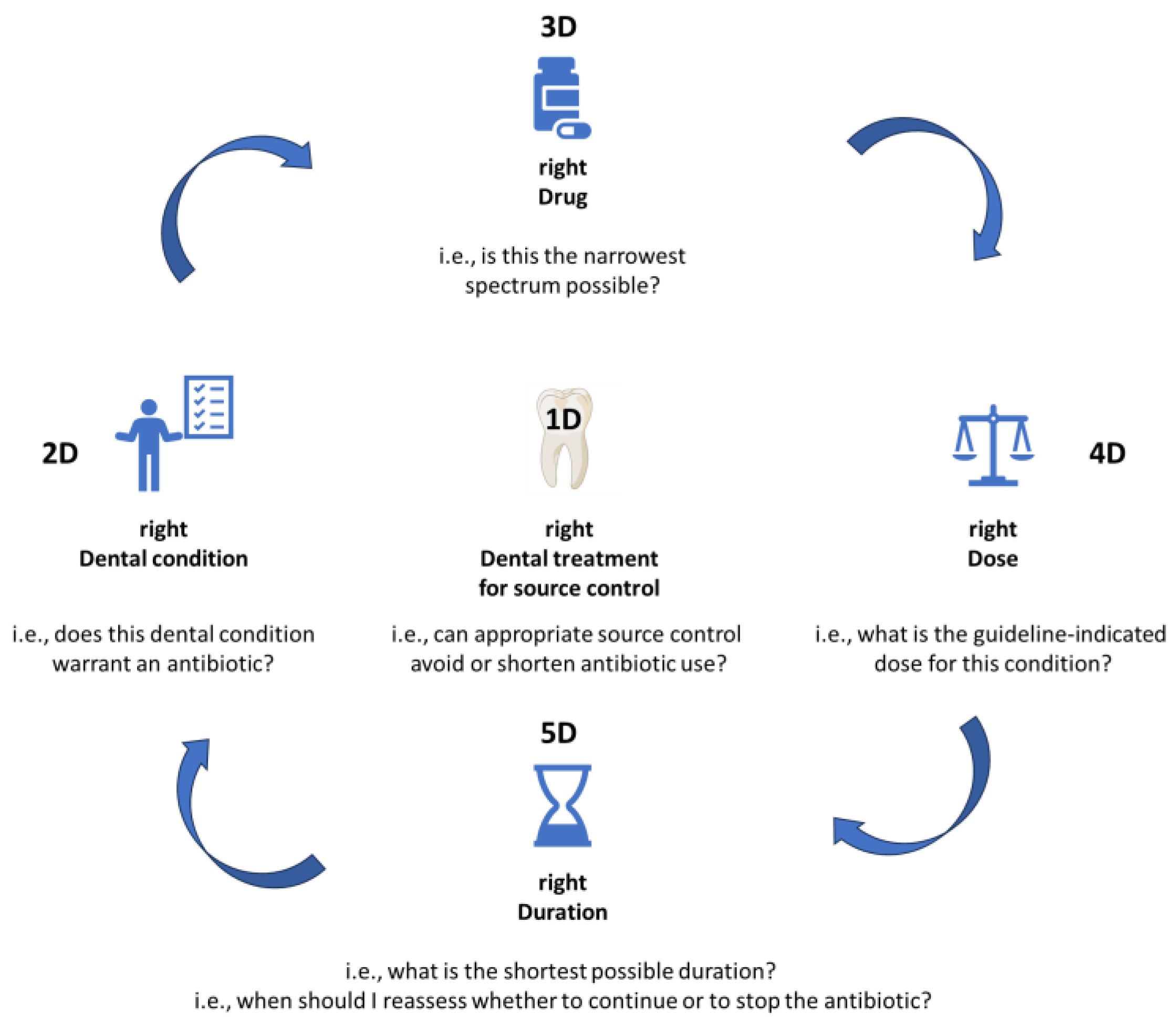The 5Ds of Optimized Antimicrobial Prescription in Dental Medicine
Conclusions
Funding
Conflicts of Interest
References
- Hutchings, M.I.; Truman, A.W.; Wilkinson, B. Antibiotics: past, present and future. Curr Opin Microbiol 2019, 51, 72–80. [Google Scholar] [CrossRef] [PubMed]
- Wilson, W.R.; Gewitz, M.; Lockhart, P.B.; et al. Prevention of viridans group streptococcal infective endocarditis: a scientific statement from the American Heart Association. Circulation 2021, 143, e963–e978. [Google Scholar] [CrossRef] [PubMed]
- Otto, C.M.; Nishimura, R.A.; Bonow, R.O.; et al. 2020 ACC/AHA Guideline for the management of patients with valvular heart disease: a report of the American College of Cardiology/American Heart Association Joint Committee on Clinical Practice Guidelines. Circulation 2021, 143, e72-227. [Google Scholar] [CrossRef]
- Nakatani, S.; Ohara, T.; Ashihara, K.; et al. JCS 2017 Guideline on prevention and treatment of infective endocarditis. Circ J 2019, 83, 1767–1809. [Google Scholar] [CrossRef] [PubMed]
- Şimşek-Yavuz, S.; Rüçhan Akar, A.; Aydoğdu, S.; et al. Diagnosis, treatment and prevention of infective endocarditis: Turkish consensus report-2019. Turk Kardiyol Dern Ars 2020, 48, 187–226. [Google Scholar] [CrossRef] [PubMed]
- Šutej, I.; Par, M.; Lepur, D.; et al. Dentists’ practice and compliance with current guidelines of infective endocarditis prophylaxis- National survey study. J Clin Exp Dent 2021, 13, e648–e652. [Google Scholar] [CrossRef] [PubMed]
- Delgado, V.; Marsan, N.; de Waha, S.; et al. 2023 ESC Guidelines for the management of endocarditis: Developed by the task force on the management of endocarditis of the European Society of Cardiology (ESC) Endorsed by the European Association for Cardio-Thoracic Surgery (EACTS) and the European Association of Nuclear Medicine (EANM). Eur Heart J 2023, ehad193. [Google Scholar] [CrossRef]
- Joseph, J.; Rodvold, K.A. The role of carbapenems in the treatment of severe nosocomial respiratory tract infections. Expert Opin Pharmacother 2008, 9, 561–575. [Google Scholar] [CrossRef] [PubMed]
- Lockhart, P.B.; Tampi, M.P.; Abt, E.; et al. Evidence-based clinical practice guideline on antibiotic use for the urgent management of pulpal- and periapical-related dental pain and intraoral swelling: A report from the American Dental Association. J Am Dent Assoc 2019, 150, 906–921.e12. [Google Scholar] [CrossRef] [PubMed]
- Dinh, A.; Ropers, J.; Duran, C.; et al. Discontinuing β-lactam treatment after 3 days for patients with community-acquired pneumonia in non-critical care wards (PTC): a double-blind, randomised, placebo-controlled, non-inferiority trial. Lancet 2021, 397, 1195203. [Google Scholar] [CrossRef] [PubMed]
- Yahav, D.; Franceschini, E.; Koppel, F.; et al. Seven versus 14 days of antibiotic therapy for uncomplicated Gram-negative bacteremia: a noninferiority randomized controlled trial. Clin Infect Dis 2019, 69, 1091–1098. [Google Scholar] [CrossRef] [PubMed]
- Turjeman, A.; von Dach, E.; Molina, J.; et al. Duration of antibiotic treatment for Gram-negative bacteremia—Systematic review and individual participant data (IPD) meta-analysis. EClinicalMedicine 2023, 55, 101750. [Google Scholar] [CrossRef] [PubMed]

© GERMS 2023.
Share and Cite
Săndulescu, O.; Săndulescu, M. The 5Ds of Optimized Antimicrobial Prescription in Dental Medicine. GERMS 2023, 13, 207-209. https://doi.org/10.18683/germs.2023.1386
Săndulescu O, Săndulescu M. The 5Ds of Optimized Antimicrobial Prescription in Dental Medicine. GERMS. 2023; 13(3):207-209. https://doi.org/10.18683/germs.2023.1386
Chicago/Turabian StyleSăndulescu, Oana, and Mihai Săndulescu. 2023. "The 5Ds of Optimized Antimicrobial Prescription in Dental Medicine" GERMS 13, no. 3: 207-209. https://doi.org/10.18683/germs.2023.1386
APA StyleSăndulescu, O., & Săndulescu, M. (2023). The 5Ds of Optimized Antimicrobial Prescription in Dental Medicine. GERMS, 13(3), 207-209. https://doi.org/10.18683/germs.2023.1386



